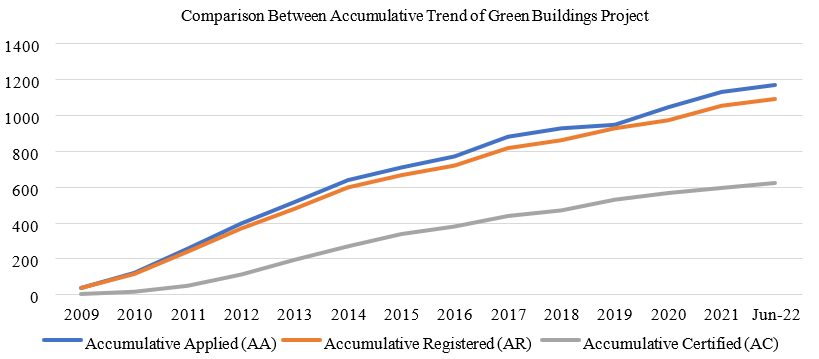Current Status of Green Building Development in Malaysia
DOI:
https://doi.org/10.37934/progee.25.1.19Keywords:
Environment Condition, Sustainable Green Building Development, Construction Industry, Sustainable Green Material, Building Life Cost CycleAbstract
Terrible environmental conditions on Earth have warned us over the past decade. To avoid the current situation going further, many countries started to implement sustainable green building development. Sustainable green building development tends to preserve and conserve the environment by using sustainable green material, decrease of negative impact from construction industry and improve on the building life cost cycle. Although the number of green buildings increased compared to last century, but adoption of sustainable green building in the Malaysian construction industry is considered slow. Besides, sustainable green building development also concerns social and economic aspects. This study will analyze the current status of green building development in Malaysia. The study has reviewed articles pertinent to green building development from reputable science databases. The result obtained showed the current status of green building development is decreasing due to the impact of Pandemic COVID-19. Furthermore, the results also showed the number of green buildings in Malaysia is comparatively low. This study provided a benchmark for policy makers and construction key stakeholders about the current status of green building development in Malaysia which can be utilized as a guideline in promoting green building development.
References
J. Hohensee, Corporate Reporting and Externalities, In State of The World 2013, DC: Island Press, Washington, 2013, pp. 154-160.
C.Y. Ha, R. Ismail, T.J. Khoo, S.R.M. Riazi, M.N. Mohd Nawi, Awareness level and factors affecting intention of Penang construction industry toward green building development, International Journal of Advanced Science and Technology 29 (2020) 1986-1998.
M.G. Samari, Nariman Esmaeilifar, Reza Olfat, Parnaz Shafiei, Mohd Wira Mohd, The investigation of the barriers in developing green building in Malaysia, Modern Applied Science 7 (2013) 1. https://doi.org/10.5539/mas.v7n2p1.
S. Wong, W. Low, K. Wong, Y. Tai, Barriers for green building implementation in Malaysian construction industry, IOP Conference Series: Materials Science and Engineering, IOP Publishing, 2021, pp. 012029. https://doi.org/10.1088/1757-899X/1101/1/012029.
W.Z.W. Yusoff, W.R. Wen, Analysis of the international sustainable building rating systems (SBRSS) for sustainable development with special focused on green building index (GBI) Malaysia, Journal of Environmental Conservation Research 11 (2014) 11-26.
C.C. Ohueri, W.I. Enegbuma, R. Kenley, Energy efficiency practices for Malaysian green office building occupants, Built Environment Project and Asset Management 8(2) (2018) 134-146. https://doi.org/10.1108/BEPAM-10-2017-0091.
R. Ciegis, L. Simanskiene, The concept of sustainable economic development and indicators assessment, Vadybos mokslas ir studijos–kaimo verslu ir ju infrastrukturos pletrai 21(2) (2010) 34-42.
N.N. Zainol, I.S. Mohammad, M. Baba, N.B. Woon, A.Q. Nazri, Green cleaning: An essential aspect of Malaysian green buildings, Jurnal Teknologi 75 (2015). https://doi.org/10.11113/jt.v75.5274.
O. Awadh, Sustainability and green building rating systems: LEED, BREEAM, GSAS and Estidama critical analysis, Journal of Building Engineering 11 (2017) 25-29. https://doi.org/10.1016/j.jobe.2017.03.010.
I.Y. Wuni, G.Q. Shen, R. Osei-Kyei, Scientometric review of global research trends on green buildings in construction journals from 1992 to 2018, Energy and buildings 190 (2019) 69-85. https://doi.org/10.1016/j.enbuild.2019.02.010.
L. Jaillon, C.-S. Poon, Y.H. Chiang, Quantifying the waste reduction potential of using prefabrication in building construction in Hong Kong, Waste management 29 (2009) 309-320. https://doi.org/10.1016/j.wasman.2008.02.015.
E. Papargyropoulou, C. Preece, R. Padfield, A.A. Abdullah, Sustainable construction waste management in Malaysia: A contractor's perspective, Management and Innovation for a Sustainable Built Environment MISBE 2011, Amsterdam, The Netherlands, June 20-23, 2011, Citeseer, 2011.
M. Taha, What a waste: solid waste management and the Malaysian perspective on construction waste generation and management, Kuala Lumpur: Solid Waste and Public Cleansing Management Corporation (2015) 14-18.
A.O. Olanipekun, A.P. Chan, B. Xia, O.A. Adedokun, Applying the self-determination theory (SDT) to explain the levels of motivation for adopting green building, International Journal of Construction Management 18 (2018) 120-131. https://doi.org/10.1080/15623599.2017.1285484.
R. Mateus, L. Bragança, Sustainability assessment and rating of buildings: Developing the methodology SBToolPT–H, Building and environment 46 (2011) 1962-1971. https://doi.org/10.1016/j.buildenv.2011.04.023.
C. Smith, H. Hancock, J. Blake-Mortimer, K. Eckert, A randomised comparative trial of yoga and relaxation to reduce stress and anxiety, Complementary Therapies in Medicine 15 (2007) 77-83. https://doi.org/10.1016/j.ctim.2006.05.001.
G. Kats, Green Building Costs and Financial Benefits, Massachusetts Technology Collaborative, 2003.
N. Atsusaka, S. LeVan, Growing the green building industry in Lane County: a report for the Lane County sustainable business and jobs project, University of Oregon, 2003.
H.H. Ali, S.F. Al Nsairat, Developing a green building assessment tool for developing countries–Case of Jordan, Building and Environment 44 (2009) 1053-1064. https://doi.org/10.1016/j.buildenv.2008.07.015.
M.A. Fauzi, N.A. Malek, Green Building assessment tools: Evaluating different tools for green roof system, International Journal of Education and Research 1 (2013) 1-14.
R. Rahardjati, M.F. Khamidi, A. Idrus, The level of importance of criteria and sub criteria in green building index Malaysia, in: International Conference on Sustainable Building and Infrastructure (ICSBI 2010), Kuala Lumpur Convention Centre, 15-17 June 2010.
N. Lazar, K. Chithra, A comprehensive literature review on development of Building Sustainability Assessment Systems, Journal of Building Engineering 32 (2020) 101450. https://doi.org/10.1016/j.jobe.2020.101450.
M.B. Esa, F.S.B. Ibrahim, E.B.M. Kamal, Covid-19 pandemic lockdown: The consequences towards project success in Malaysian construction industry, City 25 (2020). https://doi.org/10.25046/aj0505119.
S.M. Algburi, A. Faieza, B. Baharudin, Review of green building index in Malaysia; existing work and challenges, International Journal of Applied Engineering Research 11 (2016) 3160-3167. https://doi.org/10.31142/ijtsrd19117.
H.C. Yee, R. Ismail, K.T. Jing, The Barriers of Implementing Green Building in Penang Construction Industry, Progress in Energy and Environment 12 (2020) 1-10.
K. Williams, C. Dair, What is stopping sustainable building in England? Barriers experienced by stakeholders in delivering sustainable developments, Sustainable development 15 (2007) 135-147. https://doi.org/10.1002/sd.308.
T.S. Wright, H. Wilton, Facilities management directors’ conceptualizations of sustainability in higher education, Journal of Cleaner Production 31 (2012) 118-125. https://doi.org/10.1016/j.jclepro.2012.02.030.
S.K. Yap, Challenges in Adopting Green Technology Building by Contractors in Malaysia, Tunku Abdul Rahman University College, 2019.

Downloads
Published
How to Cite
Issue
Section
License
Copyright (c) 2023 Progress in Energy and Environment

This work is licensed under a Creative Commons Attribution-NonCommercial 4.0 International License.











